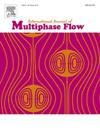Significance of recirculating micro-bubbles in oxygenation from poly-dispersed plumes
Abstract
Poly-disperse bubble plumes are simulated to explore the effect of interactions between multiple bubbles of varying sizes on the liquid flow, plume dynamics, and oxygen transfer in aeration processes. An Eulerian-Lagrangian model based on the multiphase particle-in-cell method (MPPIC) implemented in OpenFOAMTM has been extended to account for bubbly flow. Bubbles have been approximated as spherical particles whose diameters change in response to pressure and nitrogen and oxygen mass dissolution and transfer. The mass transfer model relies on a Sherwood number correlation which accounts for the individual bubble size and relative velocity and is parameterized against the liquid phase temperature. A Large Eddy Simulation (LES) approach based on a transport equation for the turbulent kinetic energy has been adopted to model the effect of the sub-grid scales (SGS) of turbulence on the liquid flow and bubble motion. The bubble injection is defined in terms of the air mass transfer and the bubble size distribution. The model has been compared against experimental measurements of the evolution in oxygen concentration in a deep water tank in response to bubble plumes generated from a porous ceramic plates at two different flow rates. The interaction between milli- and micro-bubbles over a wide range of sizes has been shown to create significant differences in the aeration process. A method to correct for bubble recirculation has been proposed and allows for good agreement between measured and simulated volumetric transfer rates. The simulation has shown the important role that the interplay between bubble sizes takes in determining the oxygen transfer efficiency. Larger standard deviations from Gaussian bubble size distributions have been shown in particular to reduce recirculation from smaller bubbles thereby reducing the aeration efficiency at an equivalent flow rate. An analysis of the age distribution by bubble size plumes suggest that the largest bubble have an important role in increasing the entrainment of smaller bubbles limiting their recirculation and reducing their retention time.

 求助内容:
求助内容: 应助结果提醒方式:
应助结果提醒方式:


